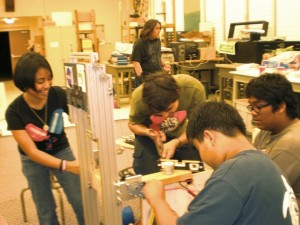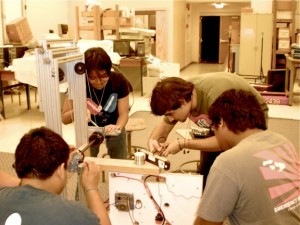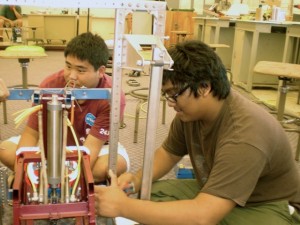Baldwin Robotics gears up for 2011 FIRST challenge
They look and sound like a sports event. They are held in arenas, like sports events. But FIRST Robotics competitions are much more.
“In a way they are the same,” said Baldwin Robotics Captain Jun Sasaki. “The same feeling of adrenaline and competition, but at the same time, a much more complex event that has you at the top of your game whether we win or lose.”
Sasaki is leading the 26 members of the Baldwin High School Robotics Club in the 2011 FIRST Robotics Competition, a challenge from U.S. FIRST to design, build and program a set of robots to compete in regional competitions involving more than 50,000 students from across the United States and dozens of countries.
For all players, the major difference is the learning that takes place.

Baldwin Robotics team members (from left) Joveline Ollero, Riyadh Khaddar, Jun Sasaki and Prescott James Lorenzo begin setting up Henry the 4th for the FIRST Robotics competition. Aaron Nawahine' is in the background .
With players on a basketball team or in a video game, practice involves honing their reaction time in making moves. For the player in a Robotics competition, practice involves adjusting and adapting an engineering design and computer programs to prepare a robot to perform on the field.
It is students incorporating physics, design, engineering and computer programming with game strategy. The goal is winning a championship; the value is the process of getting there.
“It’s about building self-confidence, respect and important relationships with people who invent new technologies to make a better future,” says Dean Kamen, founder of FIRST (For Inspiration and Recognition of Science and Technology).
Baldwin Robotics is among five high school teams in the Maui District signed up for the 2011 FIRST competition, “LOGO MOTION.” They may have the most ambitious plans, which includes going to the San Diego Regional Competition March 10-12, as well as the Hawaii Regional Competition March 24-26. The bigger target is the FIRST Robotics Championship April 27-30. The team is accepting donations to assist with competition costs.
Just as in any sport, competition helps team members focus on what they aim to accomplish.
“It’s a lot of work but it really fascinates me. It all depends on the design and programming to make the robot work,” said senior Brittany Nakamoto. “I can imagine myself being involved in science or technology. Being a part of this program has influenced me a lot.”

Team members working on robot frame: Jun Sasaki (front), Joveline Ollero, Riyadh Khaddar, Prescott James Lorenzo.
Nakamoto and her teammates agreed that communications among the members is a key factor in achieving their goals.
Senior Riyadh Khaddar said the lesson he will take away from his three years with Baldwin Robotics is “how important communication is to the function and coordination of the team.” Fellow senior Aaron Nawahine said he values “the teamwork and life skills we learn from the program.”
They are all focused for now on implementing their designs for two robots for the “LOGO MOTION” competition. A primary robot will maneuver on a 27- by 54-foot playing field, placing logo pieces – triangles, circles and squares that are elements of the U.S. FIRST logo – on scoring pegs protruding from a series of towers set up on each end of the field. In a match, the robot must operate independently – without a driver – for the first 15 seconds, retrieving and placing colored tubes on the scoring pegs. For the next 2 minutes, a driver operates the robot.
Near the end of a match, a Minibot is to be deployed from the primary robot, programmed to climb a vertical pole on the field to trigger a sensor. The first Minibot to hit a sensor scores the most points.
Baldwin Robotics member were challenged by both assignments. They sorted through design options for their robot to pick up game pieces from the field and place them on scoring pegs. Then there was a need to engineer a method to deploy a Minibot that would be designed and programmed to run independently once deployed.
Chaz Cabero, Dillon Nagata and Khaddar said deploying the Minibot will be the most difficult element of the challenge. Nakamoto, Nawahine, Lauren Unemori and Curtis Keomaniboth said designing and programming the primary robot for scoring is the toughest challenge, especially during the autonomous 15-second period when programming counts for everything.
Team Captain Sasaki is focused on getting it all right.
“Following the rules to build a very competitive robot to win the competition,” he said. That will be the toughest task. With his three years of experience, he feels the team is up to it.
“I just like building stuff and making my ideas a reality,” he said. “I like to see our ideas work. The other part is the competition. We did pretty good last year and it was our own design, our own ideas that worked.”
***********
The Baldwin Robotics team is accepting donations to support its effort to compete in two FIRST Robotics regional competitions. Tax-deductible donations may be made to the team through the HP Baldwin High School Foundation, P.O. Box 96733, Kahului, HI 96733. Information on the foundation is at hpbaldwinhighschoolfoundation.org.
(Submitted by Ed Tanji; Posted by Wendy Osher)










